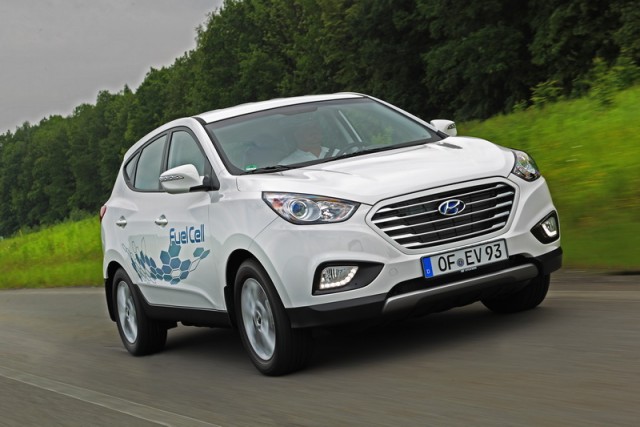Good: near identical looks to standard version, five-star NCAP.
Not so good: reliant on what is still an extremely limited infrastructure.
South Korean car manufacturer Hyundai has taken what was once an idealistic future concept - hydrogen powered vehicles - and put it into full production. And, more importantly, it is being showcased not in a quirky-looking form, but in its ix35 crossover model.
From the outside there is little to differentiate the ix35 Fuel Cell from the more conventionally powered model. It does have a unique front grille design to give it some identity while the rear bumper no longer has the need to accommodate an exhaust pipe in the traditional sense. There is an exhaust pipe there, but it is in the form of a much smaller drain underneath, which allows the ix35 Fuel Cell's only emissions - water - to escape. It may seem like a bizarre idea, and in person it is even stranger to see, but the only thing that is emitted from the propulsion process is pure water. Hyundai engineers say that, although it is not recommended for human consumption (as the water has essentially been through the engine and other innards of the ix35 Fuel Cell), it is perfectly useable for watering your plants or topping up your screen washer bottle. That said, there is no officially designed method for collecting it as yet.
One of the reasons for Hyundai choosing to use the ix35 platform for its Fuel Cell technology is that, being a crossover vehicle, there is virtually no loss of space inside despite the fitment of two hydrogen tanks underneath the boot floor. Neither rear passenger room nor boot space is seriously restricted and even more importantly for consumer confidence, the ix35 Fuel Cell scores a full five stars in the Euro NCAP test.
Internally, the fuel cell - which is mounted under the bonnet - uses a process to generate electricity that is then stored in hybrid battery packs located in the centre of the vehicle. The fuel cell consists of a polymer electrolyte membrane in between an anode and cathode. Hydrogen flows over the anode causing it to split into hydrogen protons and electrons. The polymer electrolyte membrane allows only the hydrogen protons to pass through it while the electrons go to an external circuit, which in turn operates the motor. Meanwhile on the cathode side both protons and electrons react with oxygen, creating water.
Filling up the hydrogen tanks is a relatively quick and straightforward process. Behind the filler cap is a nozzle similar to an air-line connection along with a small infrared sensor that 'talks' to the hydrogen station's filler in order to monitor the rate of flow and pressure. There are two types of hydrogen filling processes - the method is the same but the pressures at which the hydrogen is pumped into the car varies between 350- and 700 bar. The only real difference between the two is the time it takes to fill, although filling with 700 bar hydrogen can also increase the available driving range. Importantly, the ix35 is capable of using either filling method, meaning that it can be filled at more locations. Generally the lower pressure is used more for commercial purposes such as public buses.
As for the driving experience itself, well, it's remarkably normal. The short drive we took was just around the perimeter of Hyundai's Nošovice manufacturing plant, but was enough to get a feel for what it would be like in town. Like an electric vehicle there is virtually no noise emitted, which, if you have never experienced it before, can seem strange. Available only with an automatic transmission, this ix35 performs just like its more conventionally powered sibling.
Currently the fuel cell technology is not available to the public; instead Hyundai is working in partnership with different organisations around the world to run small fleets in on-going trials. Due to this it was difficult to establish an exact cost per vehicle as representatives were remaining tight-lipped. Although it remains a limited production run, it is nonetheless a positive development that a mainstream manufacturer like Hyundai has made the decision (and investment) to do so.
Alternatives:
Honda FCX Clarity: although also only on a lease basis, the Honda is available to the public - but only if you live within range of a hydrogen filling station.












































